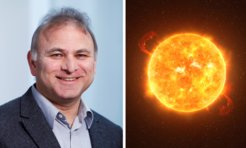ERC Advanced Grant for Sami Solanki
The project WINSUN combines a new generation of observational data with computer simulations to provide a comprehensive view of the Sun's magnetic field.
The European Research Council (ERC) has awarded Prof. Dr. Sami Solanki of the Max Planck Institute for Solar System Research (MPS) one of the prestigious ERC Advanced Grants. Over the next five years, the funding, totaling 2.5 million euros, will make it possible to fundamentally advance and complete our picture of the Sun's magnetic field. To this end, Solanki is relying on a new generation of space missions and solar observatories that are beginning or about to begin operations. The new research infrastructure not only provides data of unprecedented detail and resolution, but also allows access to regions of the Sun that could until now not be observed. Together with computer simulations, this will provide an unprecedentedly comprehensive view of our star. For the current funding period, the European Research Commission received more than 1600 applications for an Advanced Grant. Only 218 of these were approved.

The Sun’s complex and highly dynamic magnetic field is one of its most outstanding features. It is responsible for a variety of characteristic phenomena - from the dark sunspots that repeatedly appear on its visible surface to the violent bursts of radiation and particles that can reach Earth as solar storms. In addition, the magnetic field controls the ever varying nature of our star, which manifests itself, for example, in its eleven-year cycle of activity as well as in significantly longer-term changes in its radiation intensity. Yet fundamental properties of the solar magnetic field are still not understood. How exactly does it form deep within the Sun? How does it behave at its poles? What processes supply it with energy? And how is this energy transported into the hot solar atmosphere? Finding answers to these questions is the goal of the project WINSUN, which has now received funding.
The time for this endeavor is favorable. Solar research is on the threshold of a kind of generational change. Older space probes and telescopes such as NASA's Solar Dynamics Observatory or the GREGOR solar telescope on Tenerife continue to provide researchers with valuable data. But most of these facilities are already entering their second decade of operation. With more advanced instruments and state-of-the-art technology, new missions and observatories will provide completely new types of observational data in the coming years. WINSUN will bring these together and supplement them with complex computer simulations of processes on the Sun. "Solar research currently has unprecedented opportunities," Solanki said. "For the first time, we can hope to understand the solar magnetic field in its entirety."
Unique data
ESA's Solar Orbiter spacecraft is playing an important role in this effort. Since last year, it has already twice approached the Sun to within one-third of the distance between Earth and the Sun. Among other things, this has produced images of the solar corona in ultraviolet light in unprecedented detail. In the coming years, the probe’s increasingly inclined trajectory will for the first time give way to a view of our star’s poles. In addition, Solar Orbiter will receive support this summer. The Indian space probe Aditya-L1 will then be launched into space and will focus its attention on a wavelength range of the Sun that has been little explored to date.
From its location in Hawaii, the Daniel K. Inouye Solar Telescope (DKIST) is also providing unique data. Already during its commissioning in 2019, the telescope’s first images of the Sun generated worldwide excitement. They had the highest-resolution ever achieved in visible light. And this was just the beginning. Recently, the commissioning has been completed and for DKIST, the daily scientific work has begun.
The fourth solar observatory on which the WINSUN project relies is Sunrise. Another flight of the balloon-borne observatory, which peers at the Sun from the stratosphere, is currently being planned. Sunrise will be able to image processes in the lower solar atmosphere more accurately than previously possible.
Prof. Dr. Sami K. Solanki is significantly involved in all these projects. For 23 years he has headed the MPS department "Sun and Heliosphere" and during this time has not only contributed decisively to our understanding of the solar magnetic field and the variability of our star, but also advanced important projects in solar research. For example, he initiated the Sunrise mission, which provides its unique view of the Sun from the stratosphere. He is also Principal Investigator of Solar Obiter's PHI telescope and Co-investigator of Arydita-L1, DKIST, and other Solar Orbiter instrument teams.
With the Advanced Grants, the European Research Council supports experienced, world-renowned scientists who are at the forefront of their research field. The funding, which extends over five years, offers them the opportunity to tackle particularly ambitious research projects. Solanki was already successful with another Advanced Grant application in 2016.
